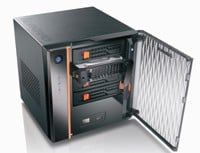Lenovo Introduces New Digital Home Servers, HTPCs, and Nettops
Lenovo has announced a new series of systems today, each of which is aimed at a different aspect of the digital home. Said home is seen as a virtual goldmine for any company that can put its finger squarely on the pulse of what consumers want, and Lenovo thinks it has a winning combination. Fresh out of the launch bay we have Lenovo's first Home Theater PC (HTPC), the IdeaCentre Q700, the D400 storage server, and the IdeaCentre Q100 and Q110 nettops. The concept of a single-point home storage server has a certain universal appeal to any techie, so let's start there.
Lenovo's D400: Atom-powered Storage Without any other systems to compare against, Lenovo's D400 seems deceptively large in photos. In reality, this storage server is just 200mm(W)x210mm(H)x220mm(D). That's 7.87"x8.3"x8.7" for anyone who prefers to think in inches, and it means that the nearly cubic server is on the small side. Full specifications are below:
Without any other systems to compare against, Lenovo's D400 seems deceptively large in photos. In reality, this storage server is just 200mm(W)x210mm(H)x220mm(D). That's 7.87"x8.3"x8.7" for anyone who prefers to think in inches, and it means that the nearly cubic server is on the small side. Full specifications are below:
Processor: Atom 230 (single) 1.6 GHz
Memory: 1 GB DDR2
Storage: 4 hard drives, up to 8 TB of total storage
Connectivity: Gigabit Ethernet – can connect to wireless router for wireless
Multimedia: 5 USB, 1 eSATA
Other: iTunes server, Lenovo PC Client, Windows Home Server service pack 2
The D400 will start at $499, which could make it an attractive option for anyone wanting a small, high-capacity server without a need for high performance. The D400 should have more than enough processing power to handle everyday storage serving tasks, but could falter if asked to stream or copy video across multiple drives simultaneously. This goes double if you intend to add external USB2 drives (for whatever reason); the additional CPU overhead of the USB interface will further tax what processing power is available. So long as you don't expect the D400 to double as a video editing machine it should serve admirably.
The Q100 and Q110 Nettop: Could this dormant market take off?
Nettops have been all but forgotten in the wake of their immensely popular portable brethren, but Intel's original vision for Atom saw the processor as a potential game-changer for both desktop and mobile segments. Netbooks may have gotten an immense amount of press in the past 14 months, but nettops are no less of a design trend. The desktop segment will never go away—there will always be users who prefer or need high-performance components that draw more power than a laptop chassis can handle. True high-performance systems will almost certainly retain the basic ATX tower shape, even if the internal form factor changes, but there's a growing market for new nettop-centric form factors that drastically shrink the size of a traditional desktop without eliminating the greater expandability and more powerful features that such a system can offer.
Enter the Q100 and the Q110. Lenovo is advertising the systems as 0.7"(W)x6.3"(H)x6"(D). That doesn't include the actual stand, and it's not clear how wide the base actually is. Either system can be mounted behind the monitor. While they share an identical enclosure, the hardware differences between the Q100 and the Q110 are greater than the ten-point model number distinction implies.
Lenovo is advertising the systems as 0.7"(W)x6.3"(H)x6"(D). That doesn't include the actual stand, and it's not clear how wide the base actually is. Either system can be mounted behind the monitor. While they share an identical enclosure, the hardware differences between the Q100 and the Q110 are greater than the ten-point model number distinction implies.
Said specifications are actually a bit confusing. The spec sheet Lenovo sent over states that both systems feature an Atom 230 processor and the SiS 672 chipset. Under the "Graphics" subsection, the same spec sheet informs us that the Q100 uses an Intel integrated solution (presumably GMA 950) and offers VGA-out while the Q110 will be built on NVIDIA's ION platform and support
1920x1080 HD output.
Something there doesn't add up; we've asked Lenovo for clarification on the issue. In this case, it would've been nice to see Lenovo opt for the newer Atom 330 processors, but the company may be holding on that option until Intel updates Atom's platform and GPU in 2010.
Other differences between the Q100 and the Q110 include the amount of RAM (1GB vs. 2GB), available storage (160GB/250GB), and possibly the preferred OS choice; both XP Home and Vista Home Premium are listed as options. Lenovo's website states that these systems will start at $229 and will be available beginning in September.
The Q700: Lenovo's Digital Home HTPC
The Q700 is the heavyweight out of these new systems and can be configured with up to 4GB of DDR2-667, an Intel Pentium Dual Core E5200, E5300, or Core 2 Duo E7500, and is built on the company's G43 Express chipset. Video output is handled either by 15-pin DSUB (VGA) or HDMI. Built-in wireless will be available on some models, and storage capacities range from 320GB-640GB. At present, Lenovo's documentation indicates that the system ships with a DVD-RW drive; hopefully an internal Blu-ray will be an option as well.
With up to 1TB of storage, the Q700 is meant to offer substantial storage capacity of its own; up to 9TB would be available if the Q700 was networked to a system like the D400. That's enough storage to hopefully sate the needs of even the most HD-hungry fans, and the fact that the system uses Core 2 Duo processors instead of Atom means HD playback should be perfectly smooth.


